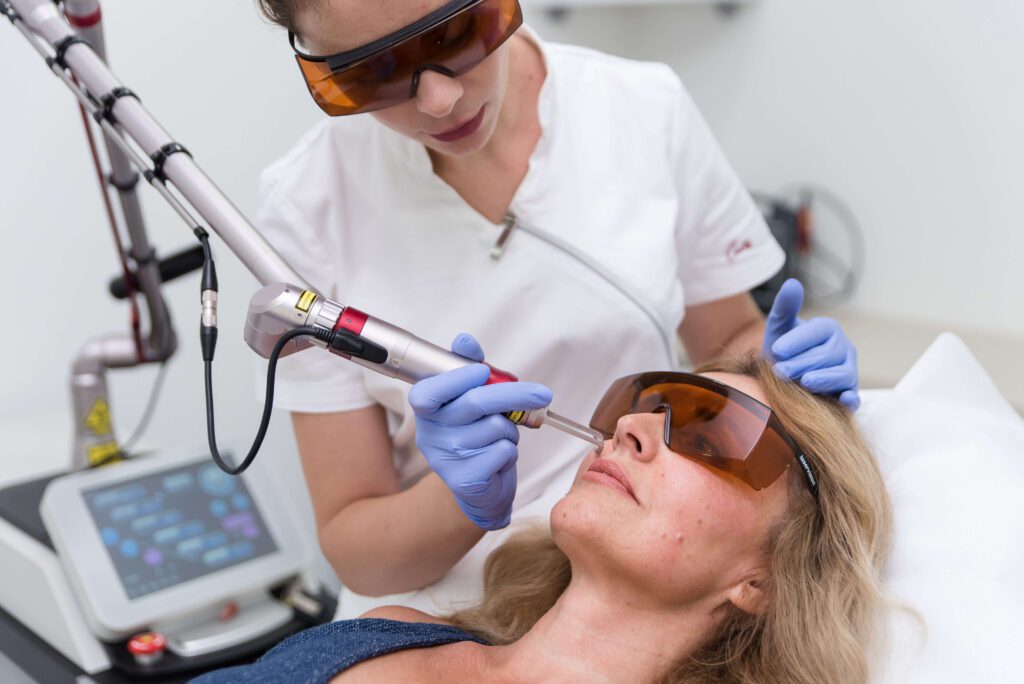Q-switch Nd Yag laser
The Q-switched Nd-YAG laser (1064 nm/532 nm) is an advanced type of laser technology designed for treating various skin conditions. The laser operates on the principle of emitting a high-energy wavelength of light, which, when focused on a particular skin condition, generates heat and destroys the affected cells. The Nd:YAG laser has a wavelength of 1064 nm and is capable of reaching deeper layers of skin tissue compared to other types of lasers. In Q-switched mode, the Nd:YAG produces two wavelengths, one in the infrared range (1064 nm) and another with a wavelength of 532 nm, which is useful for superficial skin lesions. The Q-switch mode refers to the technique by which the laser produces a high-intensity beam in very short pulses.

Treatment
Lasers are effectively used for the removal of pigmentation, tattoos, vascular changes, permanent hair removal, onychomycosis (fungal nail infection), and for skin rejuvenation and renewal. During the treatment, one might feel a sensation of stinging, pricking, and warming which can be reduced by contact cooling and, if necessary, local anesthesia. After treating vascular changes, pigmentation, tattoos, and hair, there can be redness and burning, possible mild swelling, and itching which can last for several days post-treatment. When removing pigmented changes and tattoos, frosting (a white glaze you see at the end of the treatment over the treated change) can appear and typically lasts for 20-40 minutes, and purpura (intense redness with possible capillary bleeding that mostly passes within several days).
Candidates
Candidates for laser treatment include people with:
- Vascular changes (capillaries, hemangiomas, venous lakes, vascular malformations)
- Pigmented changes (melasma, sunspots, moles)
- Unwanted hair they wish to permanently remove
- Tattoos (blue, gray, or black)
- Fungal nail infection
Results
The number of treatments depends on the type of change being treated.
How many laser treatments are needed for specific changes?
Vascular lesions: The number of sessions depends on the form, size, and position of the lesion, and skin type. Smaller capillaries can typically be removed in just 1 to 3 treatments. Larger veins and spider veins may require several treatments.
Pigmented changes: The number of treatments varies based on the type of pigmentation; while solar lentigines typically disappear after one treatment, melasma might need several sessions.
Hair removal: Patients usually require 6-8 treatments, roughly every 4 to 6 weeks. Those with darker skin types might need more sessions.
Tattoo removal: The tattoo’s color and pigment depth influence the duration and outcome of the laser tattoo removal process. Several treatments (5 to 20) may be necessary, spaced at least 4 weeks apart.
Fungal nail infection: 5-10 treatments, spaced two weeks apart, are typically required for full effect.
Recovery
Side effects are rare and mild. There can occasionally be the development of hyperpigmentation or hypopigmentation on the skin. Blisters, bruises, scars, and bacterial infections are rare. Symptoms peak about 48 hours post-treatment. When treating pigmented changes and tattoos, scabs form on the skin surface and peel over a period of 3-10 days (sometimes up to 15 days). A reactivation of Herpes Simplex is possible, so if you have frequent outbreaks, inform the doctor prior to treatment. To prevent unwanted side effects, it’s essential to follow the doctor’s instructions. Post-treatment, avoid sun exposure, tanning beds, saunas, and strenuous physical activity until the skin has fully healed. Only use creams and preparations recommended by the doctor on the treated area. When exposed to the sun, a high SPF is mandatory.